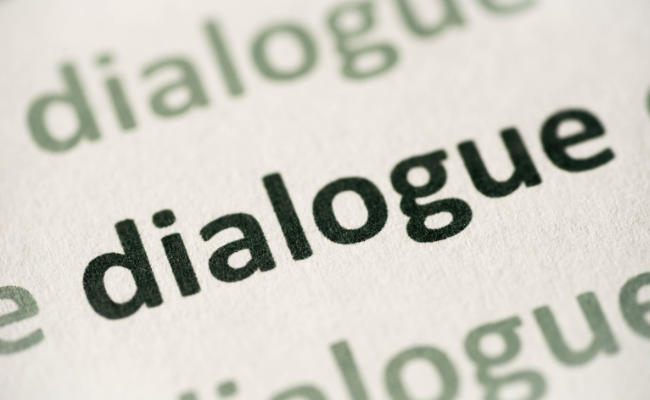Dialogue: Beyond Speaking & Listening with Bhakti Karkare
“A dialogue is not an event. It’s a process that’s not going to happen in one meeting, and it’s a journey that requires a lot of commitment to listening, to honesty, and to vulnerability.”
– Bhakti Karkare
I had the delight of speaking with Bhakti Karkare, a leadership development consultant and learning strategist known for her work with groups, individuals, and organizations. Her decade-long corporate experience with global HR teams helps her bring unique cultural insights to consulting and speaking engagements.
She is on a mission to help leaders learn to use the power of dialogue to create inclusive, engaging, and more human workplaces.
We discuss:
- Three shifts in perspective that empower Bhakti’s practice as a master facilitator
- Why true, powerful dialogue is beyond speaking and listening
- The difference between a conversation and a dialogue
Three shifts in perspective that empower Bhakti’s practice as a master facilitator

The first workshop Bhakti facilitated was near-perfect. She rushed to tell the senior facilitator of her triumphs and shared that she felt confident throughout the workshop, she was able to answer everyone's questions, and she believed they learned a lot.
Her mentor looked at her and asked if she wanted to be a facilitator in the long term. She said she did. He then gave Bhakti the mindset shifts that would guide her career and the outcomes she should strive for in each workshop:
- Instead of coming out saying you felt confident, say I think I’ve made them feel confident
- Instead of saying I think I answered all of their questions, say I think I asked the right questions
- Instead of saying I think they learned a lot, aspire for them to be able to reflect
“These three shifts that he offered became the foundation of my understanding of the world of facilitation, which went on to become part of my work on dialogue, and it still guides my mission and understanding of dialogue,” Bhakti says. “That was the time I truly became aware of the power of dialogue and started using it more and more. I'm still working with it and seeing amazing results when I attain those outcomes in the groups I facilitate.”
Putting the focus on the people she is serving continues to make all the difference and relieve some of the pressure to be perfectly polished and eloquent at all times. The power is with those in need of her services.
Why true, powerful dialogue is beyond speaking and listening

Speaking and listening are only one side of dialogue, the “Doing.” The act of listening, speaking, and asking questions. It’s tactical. Beyond the doing is the being.
“The being is about your mindset, your awareness of self and those involved in the dialogue,” Bhakti says. “It is also about knowing the objective and avoiding all distractions like assumptions, judgments, and notions about others involved. And that's your being. It's more about self-awareness and awareness of your surroundings.”
The biggest part between being and doing is what Bhakti calls the in-between. The in-between is the space created dynamically and is always there, even when the being and the doing are gone. This space is the energy and the relationship built while we conduct dialogue. When the being and the doing conclude, the space becomes the foundation for the following discussion.
“A lot of times, our focus when it comes to conversation is on this doing—What do I say? What do I ask? How do I listen? How do I empathize?—And that's, of course, a very essential part of a dialogue,” she continues. “But a true facilitator of dialogue also at the same time focuses on, ‘How is this questioning and asking and listening impacting the space that's created? And what is my role at this moment as a facilitator?’ Sometimes, we forget that the role as a facilitator of this dialogue is to see forward movement.”
The goal of a dialogue is not to win an argument or make someone agree with a point of view. A successful discussion considers all three aspects—doing, being, and the in-between—to create a dialogue that may not lead to an end result right then but builds the opportunity for a sustained dialogue over time, leading to success.
The difference between a conversation and a dialogue

Dialogue is a journey that requires many commitments—to listen, suspend judgment, to be open and honest, and to be vulnerable. To be uncomfortable. The difference between a casual conversation and a dialogue lies in the need for forward motion in any capacity.
“A chat or a conversation is a lot about speaking and listening, a conversation can end abruptly,” Bhakti says. “Dialogue is specific in the way that it is meant to create forward movement. It is meant to create change. A conversation may not necessarily create any shift, change, movement, or discomfort.”
If we look at the core of what we mean by facilitating a dialogue, a successful dialogue creates a forward movement—whether for learning, problem-solving, decision-making, etc. It can be a slight movement or full-force transformation, but it is always forward-looking.
Adopting a facilitator's mindset is the primary step in understanding the power of dialogue, alongside building a skillset and practicing that skill set diligently. Every leader can benefit from incorporating the full scope of dialogue into their team.
When have you opened a dialogue at work? If so, what was the forward motion?
Be sure to check out Bhakti’s full episode for further insight into the three steps of adopting the facilitator mindset and learn more at ThirdLoopLearning.com!








